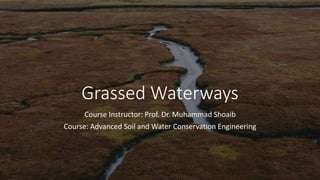The document discusses the design of grassed waterways. It defines grassed waterways as natural or manmade open channels protected with grasses or shrubs that are constructed along slopes to drain runoff from terraces or graded bunds. The key design parameters discussed include peak runoff rate, permissible flow velocity, waterway cross-sectional area, length, width, depth, grade, and shape. Equations for calculating time of concentration, rainfall intensity, and peak runoff rate using nomographs are also provided. A step-wise design procedure is outlined that involves sizing the waterway based on runoff calculations and checking the velocity using Manning's formula.










































































